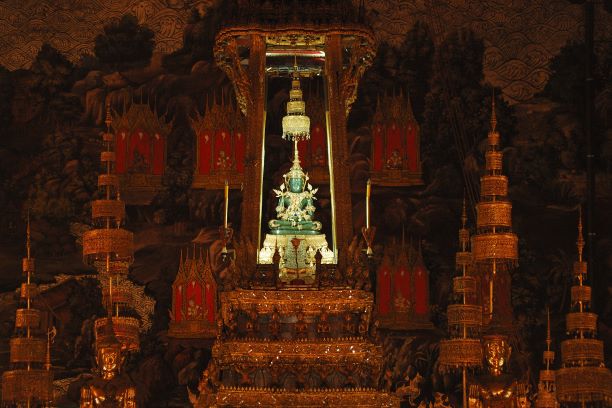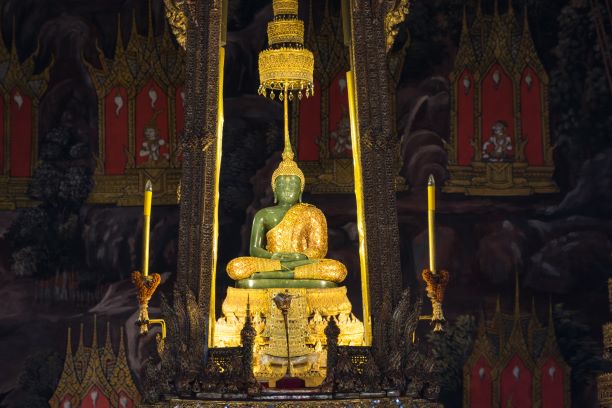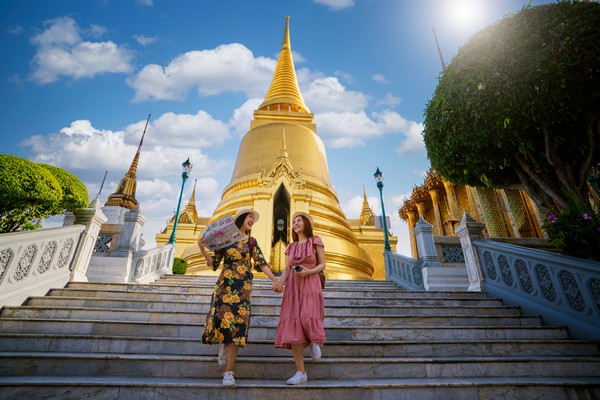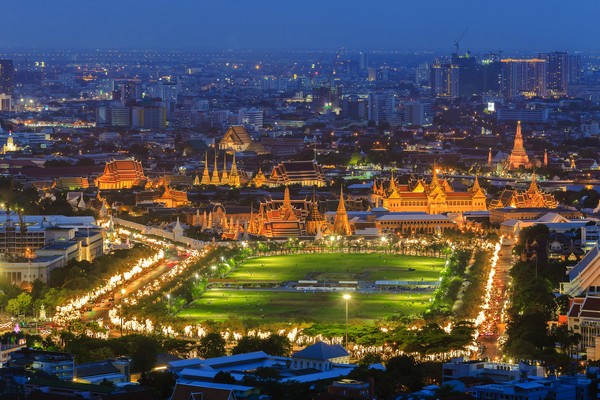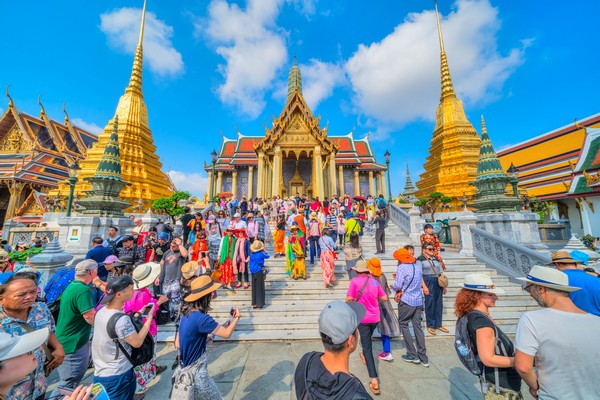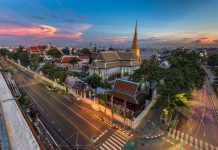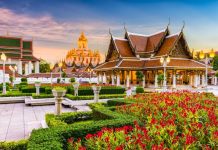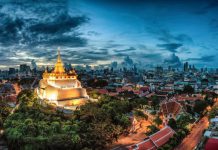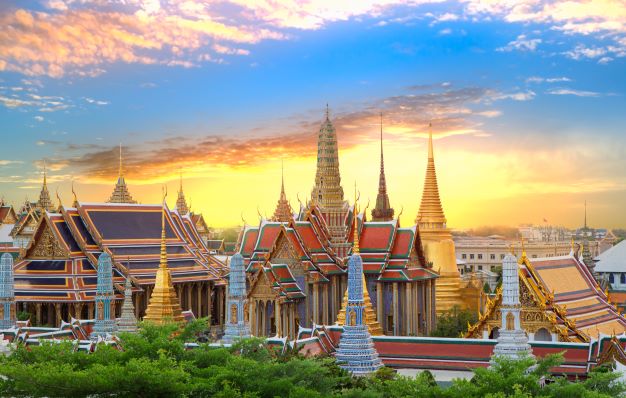
Wat Phra Kaew or known among foreigners as the ‘Temple of the Emerald Buddha‘ or its official name Wat Phra Si Rattana Satsadaram, is regarded as the most sacred temple in Thailand. The place is one of the most famous tourist destinations in Thailand for both locals and international. The remarkable monastery was established at the same time of the settlement of the Rattankosin empire in 1782 within the religious service of the grand palace following to the model of Wat Phra Si Sanphet in Ayutthaya era.
The temple is the house of the Emerald Buddha (Phra Kaew Mor Ra Kot), the Buddha image in the attitude of meditation, made from emerald-green gemstone. And with very faithful respect towards the sacred image, king Rama1 of Rattanakosin ordered the creation of the indefinite seasonal attires as a worship to put on the Buddha image. These are Summer, Rainy and Winter attires.
The Emerald Buddha is a potent religio-political symbol and the palladium (protective image) of Thai society. Each day, a lot of people from around come to visit and pay respect to the image in order to be fortunate and prosperous for life and family. And for the temple itself is very outstanding beautiful and rich in historical and cultural values.
So, it is not surprise that there are many tourists allured to witness this place with their eyes for once in their life. A few years ago, Bangkok Poll did a survey to the foreign tourists and found that the Temple of the Emerald Buddha is the most impressive destination of Thailand among the foreigners.
History of the Emerald Buddha
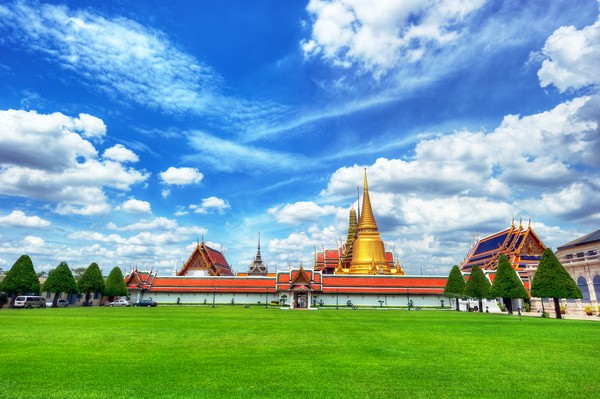
According to the records, in 1782, King Rama1 succeeded to the throne and founded the Chakri Dynasty, and he decided to move the capital across the river to Bangkok as it would be better protected from attack. He started the construction of the Grand Palace so that the palace may be ready for his coronation in 1785. Wat Phra Kaew, which has its own compound within the precinct of the palace, was built to house the Emerald Buddha, which is considered a sacred object that provides protection for the kingdom. Wat Phra Kaew was completed in 1784. The formal name of Wat Phra Kaew is Phra Sri Rattana Satsadaram, which means “the residence of the Holy Jewel Buddha.”
Wat Phra Kaew has undergone a number of renovations, restoration and additions in its history, particularly during the reigns of King Rama 3 and Rama 4. The king Rama 3 started the renovations and rebuilding in 1831 for the 50th Anniversary of Bangkok in 1832, while the king Rama 4’s restoration was completed by the king Rama 5 in time for the Bangkok Centennial celebrations in 1882. Further restoration was undertaken by Rama 7 on Bangkok’s 150th Anniversary in 1932, and by the king Bhumibol or Rama 9 for the 200th Anniversary in 1982.
Wat Phra Keaw or Wat Phra Si Rattana Satsadaram was built in the Rattanakosin era, located within a precinct of the Grand Palace. Along the Ubosot’s wall, there is a painting of Ramayana Epic which is the most beautiful and longest in the world.
Highlight of the Place
As a house of the most sacred object of the Kingdom, Wat Phra Keaw or Wat Phra Si Rattana Satsadaram has a significant and masterpiece of art for its architectures and decorations. Along the Ubosot’s wall, there is a painting of Ramayana Epic which is the most beautiful and longest in the world. The temple complex has its plethora of pavilions and monuments that are opened to public and as the magnet for all tourists. These are:
1. The Emerald Buddha at Wat Phra Keaw
The Emerald Buddha is a Lanna craftsman Buddha image in the attitude of meditation and made from flawless fine green gemstone which is very rare and valuable. It was created in 20th Buddhist century and was invited from Vientiane by the king Rama 1 to house in the royal temple of new capital and becomes as a religio-political object of the nation. There are three special attires to put on the Emerald Buddha seasonally and it is a royal tradition for the king to change the attire for the Buddha since Rama 1 abidingly. And the schedule of changing the attire based on the lunar system calendar are;
- The 1st waning moon of the 4th month, change from Winter to Summer attire.
- The 1st waning moon of the 8th month, change from Summer to Rainy attire.
- The 1st waning moon of the 12th month, change from Rainy to Winter attire.
So, avoiding to visit during those times is recommended, although the palace is opened to public.
2. Ubosot of Wat Phra Kaew

The main temple was constructed in the reign of Rama 1 with elegant structure and decoration. The roof is embellished with polished orange and green tiles, the pillars are inlaid in mosaic and the pediments are made of rich marble, installed around 18th century. It has lotus-flower-shaped pedestal decorated with gold-plated metal Garuda stops Naga surrounded by copper pillars for all of 4 corners.
The wall around the Ubosot, during the period of Rama 1, was painted with watercolor on red background, and then Rama 3 refurbished the wall painting and several frescoes that display the various stages of the Buddha’s life. They all are decorated with gold-plate and glass as well as for all doors and windows. And at the stair hill, there are 12 Singha statues that were prototyped from Khmer.
3. Mural Painting inside Wat Phra Kaew
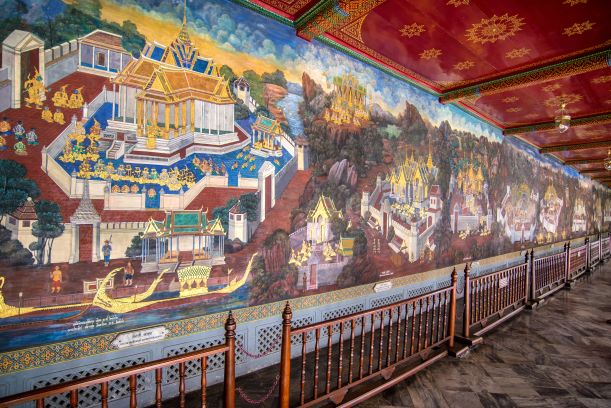
The mural painting of the Temple of the Emerald Buddha is one of the most crucial parts of this place. This typically Thai style mural indicating the story of ‘Ramayana Epic’ on 178 wall screens which has been declared as the ‘longest mural painting in the world’.
4. Prasart Phra Debidorn
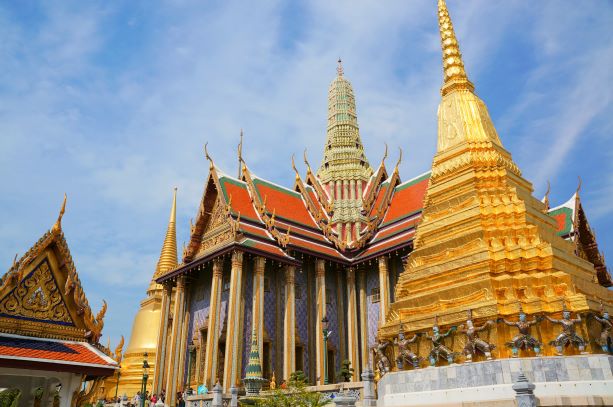
Prasart Phra Debidorn, which means “The Shrine of the celestial Ancestors”, or also called the Royal Pantheon was constructed during the reign of King Rama 4 in 1855. In 1903 the gilt stupa and part of the edifice were destroyed by fire. King Rama 6 repaired the building as the Royal Pantheon of the Chakri Dynasty. He then installed life size statues of the five preceding kings, those of King Rama 6, 7, and 8 were installed later.
Furthermore, it also houses to the portraits of the Chakri Dynasty kings. The Royal Pantheon is open to the public each year on April the 6th, the anniversary of the founding of the Chakri Dynasty, to pay homage to their past sovereigns.
5. Phra Mondop or the Library at Wat Phra Kaew
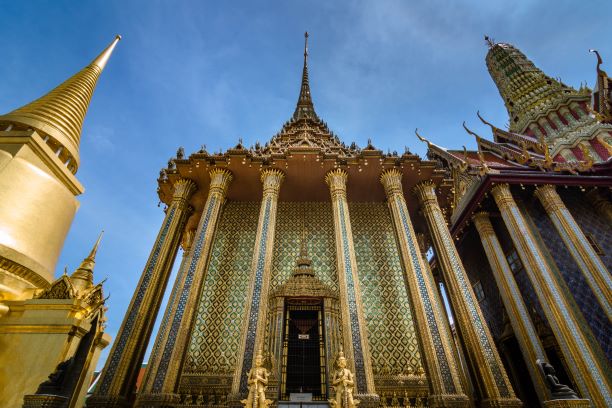
The Library, located behind to the Prasart Phra Debidorn, was built by Rama I. The library houses an elegantly carved Ayutthaya-style mother-of-pearl doors, bookcases with the Tripitaka (sacred Buddhist manuscripts), human-and dragon-headed nagas (snakes), and images of the Chakri kings.
6. Phra Si Rattana Chedi
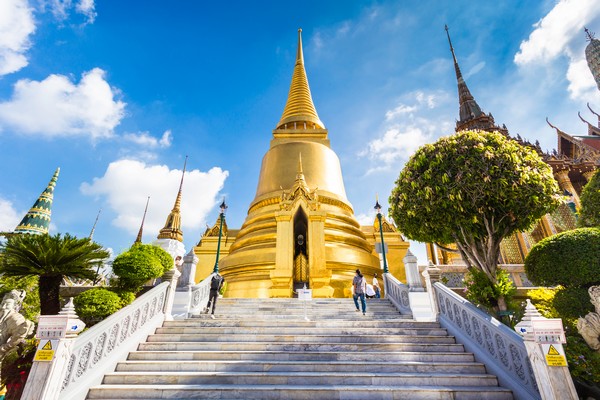
The Chedi (pagoda) represents the changing centers of Buddhist influence. One such shrine to the west of the temple as modeled from Wat Phra Si Sanphet in Ayutthaya era is the Phra Si Ratana Chedi, a 19th-century stupa built in Sri Lankan style enshrining ashes of the Buddha.
7. Phra Asada Maha Chedi or the Eight Towers
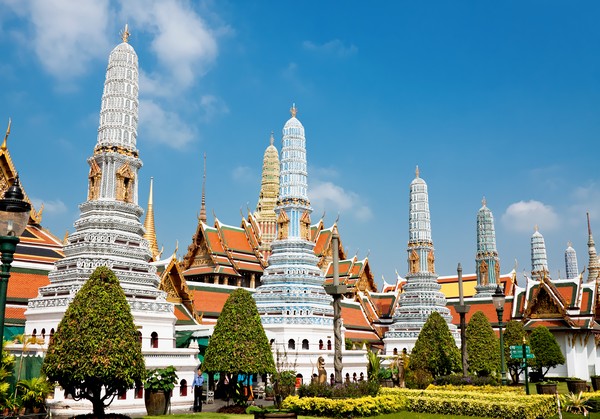
On the eastern side of the temple premises there are eight towers or prangs, which its official name is ‘Phra Asada Maha Chedi’. Each one of these towers has a different color. They were erected during the reign of Rama 1 and represent eight elements of Buddhism.
8. Yaksa Tawanbal
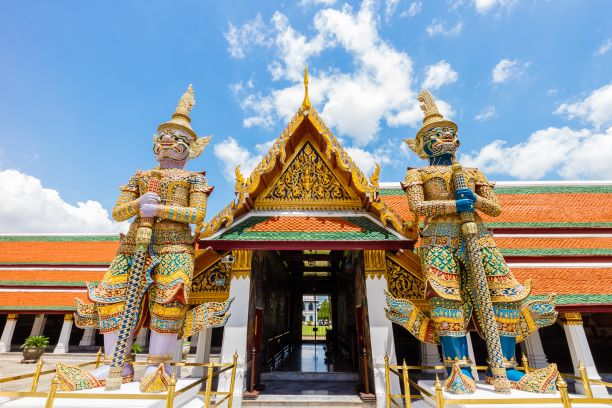
This outstanding and signature objects of the Temple of the Emerald Buddha called “Yaksa Tawanbal” which means the ‘Gate-keeper Giants’. It is assumed that they were created during the reign of Rama 3 at same time of the giant in Wat Arun and Wat Pho. Each entrance of the balcony is guarded by a pair of these giants, that its characters taken from the Indian Ramayana Epic in total 12 characters, ordering clockwise starts from a gate in front of the Prasart Phra Debidorn are Suriya (red), Indra Chit (green), Mang Korn Kan (green), Wirun Hok (dark blue), Thotsakhirithon (green), Thotsakhiriwann (ash), Korawat (white), Asakan Mara (violet), Thotsakan (green), Sahasadecha (white), Mayarap (light purple) and Wirun Chambang (grey).
9. Viharn of the Gandhara Buddha image
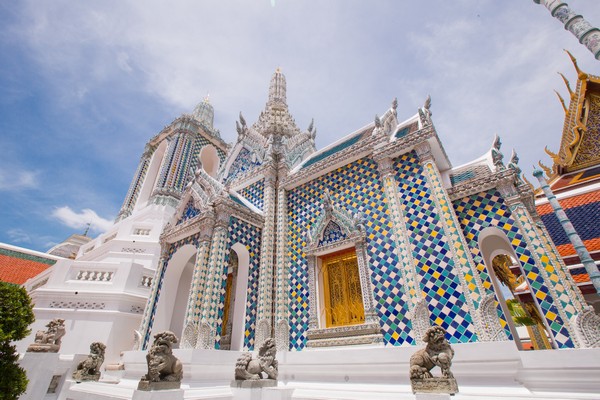
At the corner to the east is the house of Gandhara Buddha image which is a remarkable sacred object for the Royal Ploughing Ceremony Day. The wall is executed with the mural paintings by Khrua In Khong, a famous painter, regarded to rain in each season and Holy rain.
10. Phra Kromanusorn
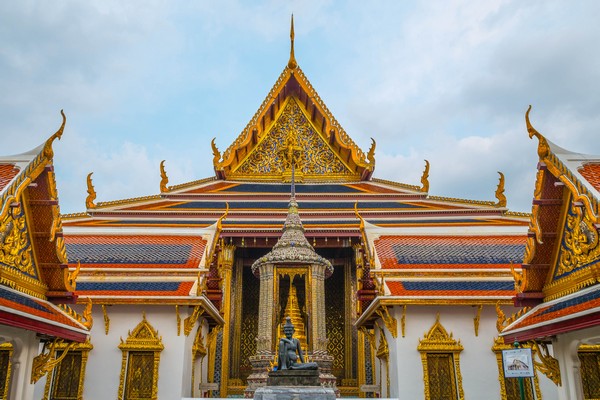
The chamber where housed of 34 Buddha images that was built during Rama 3. three chambers were added on the western side by King Mongkut; in the chamber known as ‘Phra Kromanusorn’ at the northern end, images of Buddha have been installed in honour of the kings of Ayutthaya. and in the 19th century, Khrua In Khong, a famous painter executed the wall murals.
11. Hermit statue at Wat Phra Keaw
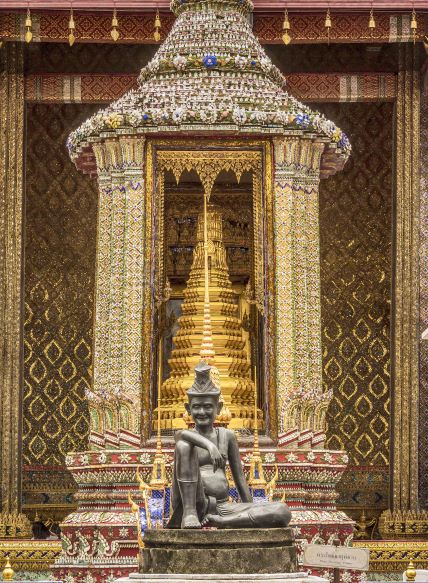
A hermit’s bronze image, which is believed to have healing powers, is installed in a sala on the western side of the temple. It is near the entry gate. It is a black stone statue, considered a patron of medicine, before which relatives of the sick and infirm pay respects and make offerings of joss sticks, fruit, flowers, and candles
12. Model of Angkor Wat at Wat Phra Kaew

The monastery complex also contains a model of Angkor Wat (the most sacred of all Cambodian shrines). King Mongkut (Rama 4) ordered the construction of the model within Wat Phra Kaew. Mongkut died before he could see the model. Its construction was completed in the reign of his son, king Chulalongkorn incelebration of the 100th anniversary of the founding of the Rattanakosin metropolitan.
Guideline to Visit the Temple of the Emerald Buddha
- Touring in the Grand Palace and the Temple of the Emerald Buddha in the morning is preferred according to during that time there is not too many tourists and not too hot.
Must dress appropriately, no sleeveless shirt, see-through, crop and shoulder-off top, no shorts, leggings, lower waist, short skirt and slipper. Anyhow, there is a facility that offer a proper dress for rental when should you need it. The rental service booth is located near the entrance ‘Wiset Chai Si’ gate with THB100 and ID card or passport of deposit, and all returned once you check out here. But better dress appropriately to avoid the queue.

Operating Time
Open daily from 8.30am – 4.00pm (Admission Ticket closed at 3.30.pm)
Admission Fee
- Thai: Free of Charge
- Foreigner: THB500 included the Temple of the Emerald Buddha, Royal Regalia, Royal Decorations and Coins Pavilion, Vimarnmek Palace. For more information, please visit www.palaces.thai.net
Map of the Grand Palace and Wat Phra Kaew
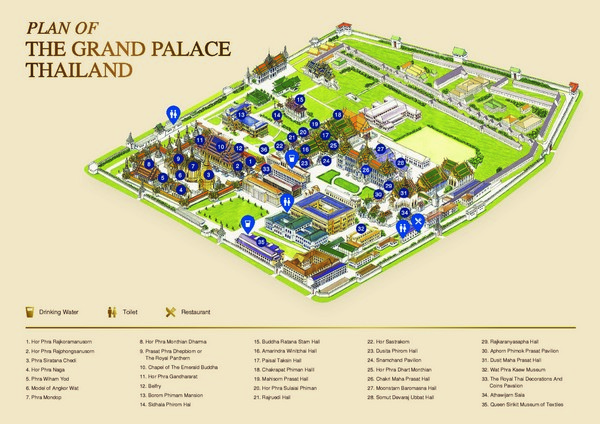
How to get to the Wat Phra Kaew
The Grand Palace and the Temple of the Emerald Buddha located at Na Phralan Road, Phraborom Maha Ratchawang, Phra Nakhon, Bangkok.
BTS + Chao Phraya Express Boat
There’s few options to travel there but this is the most convenient and fastest option. Following is the direction.
- BTS at the destination Tak Sin Bridge Station take the exit 2
- Walk to the Chao Phraya River, there is Sathon Pier, then take the Express Boat (Orange Flag)
- Get off at Tha Chang Pier (N9), then walk from the pier to the Grand Palace (on the right)

*note:
- The boat service is more during weekdays
Mon – Fri, Orange flag boat (6.00am – 7.00pm) departs every 10 – 20 minutes.
Sat – Sun, Orange flag boat (6.00am – 7.00pm) departs every 20 -25 minutes.
- Traveling by boat is not suitable for one with small children or seniority since it is very fast and quick stop.
- Before Tha Chang is Tha Tien Pier (N8), so please be prepared to get off the boat in prior, otherwise can get off to next stop which is Wang Lang (Pran Nok) Pier, same one as Sirirat Pier (N10), and then get the ferry to cross back to tha Chang Pier (ferry fee is THB3).

